专题十一 简单句 课件(共54张PPT) 2025年中考英语译林版语法专项复习(江苏)
文档属性
| 名称 | 专题十一 简单句 课件(共54张PPT) 2025年中考英语译林版语法专项复习(江苏) | 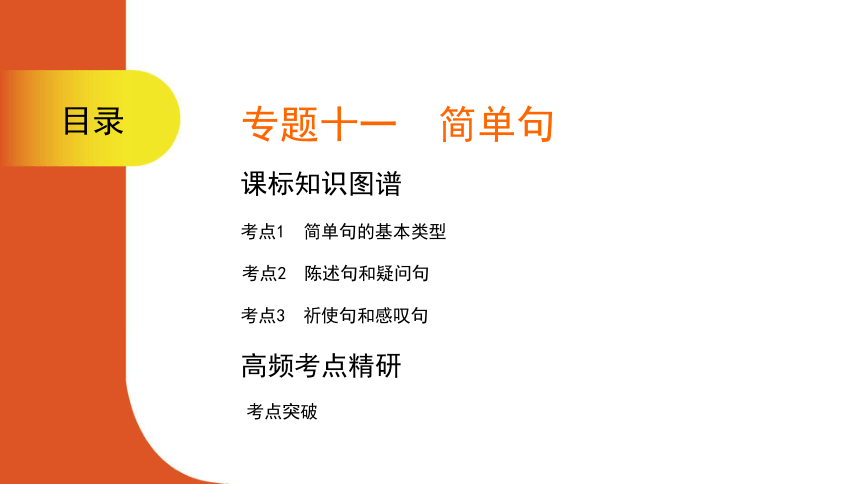 | |
| 格式 | pptx | ||
| 文件大小 | 1.0MB | ||
| 资源类型 | 教案 | ||
| 版本资源 | 牛津译林版 | ||
| 科目 | 英语 | ||
| 更新时间 | 2024-12-09 18:43:19 | ||
图片预览

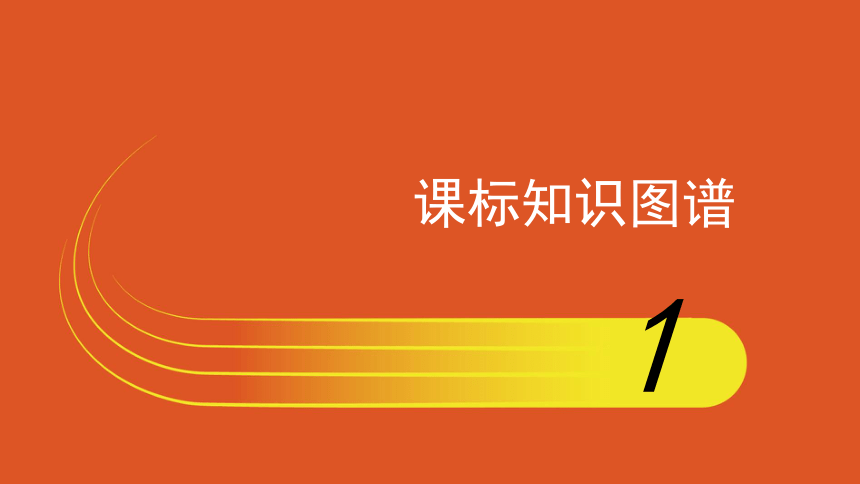
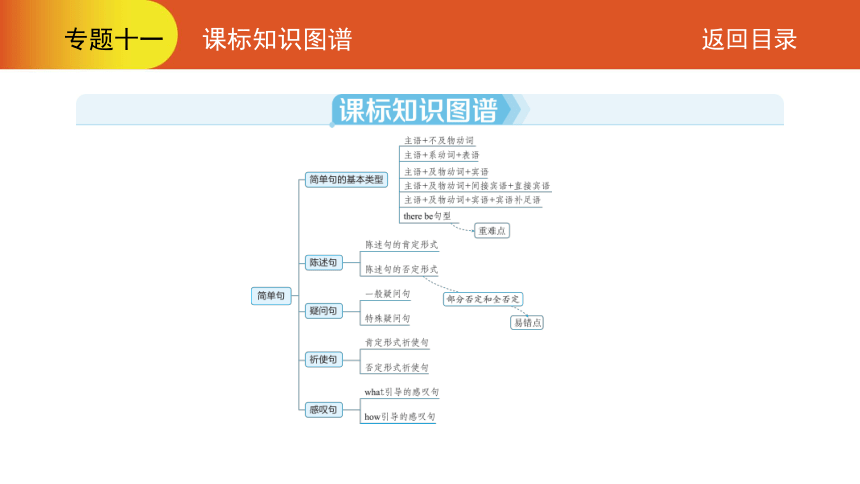
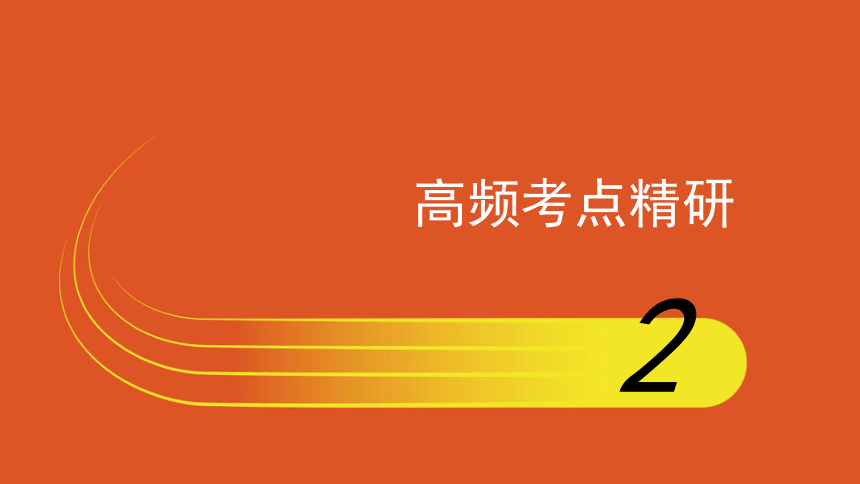
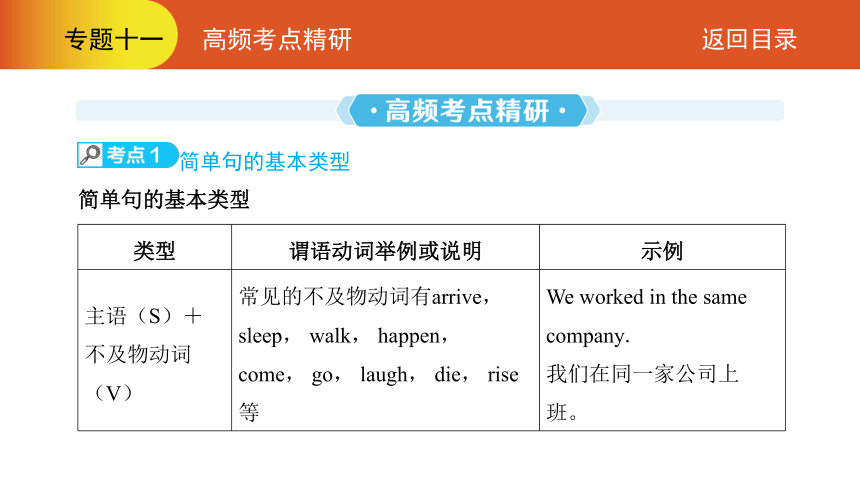
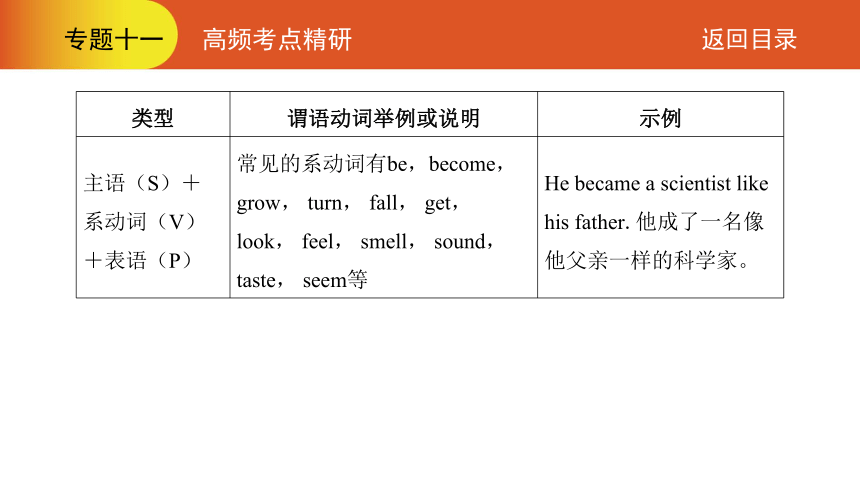
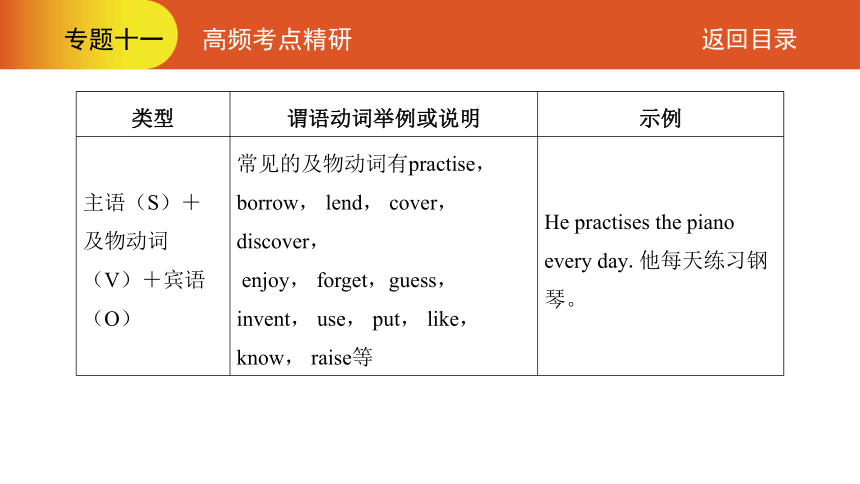
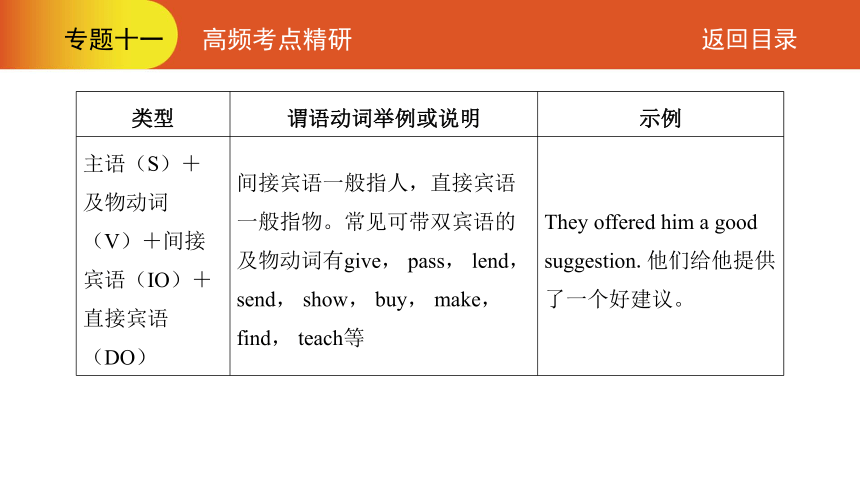
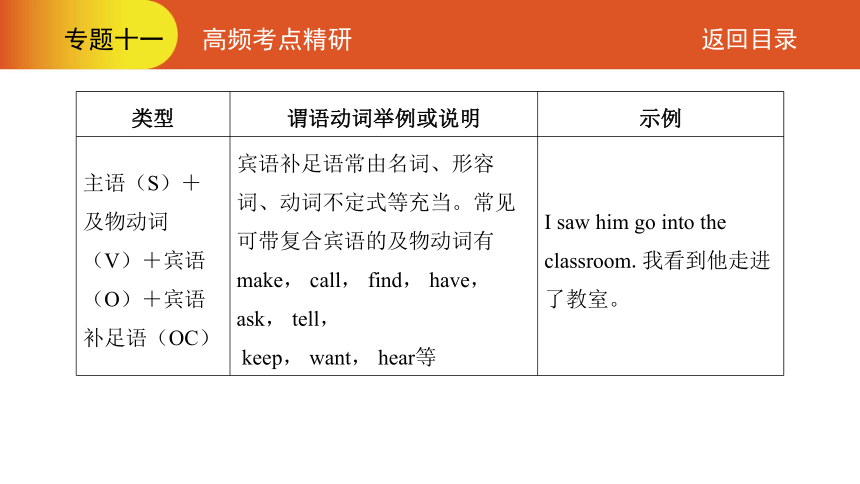
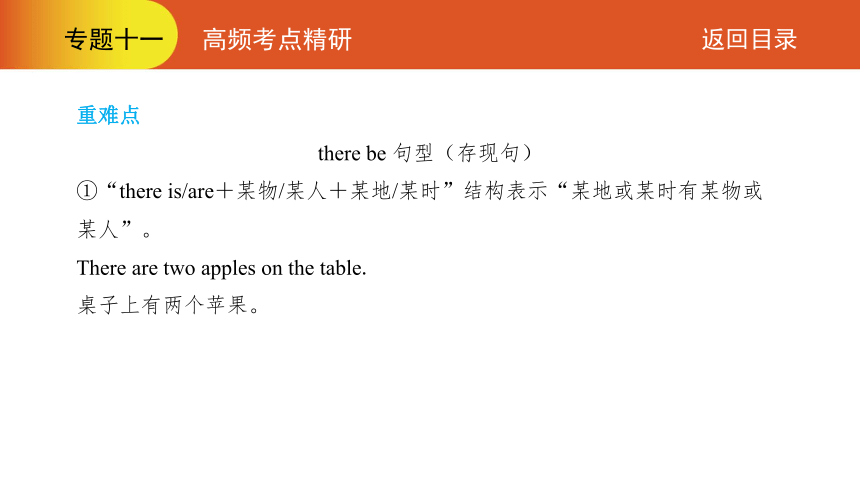
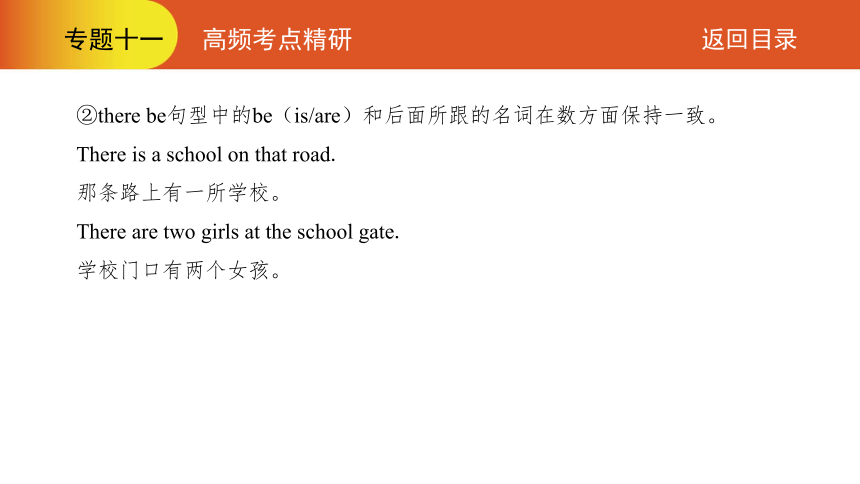
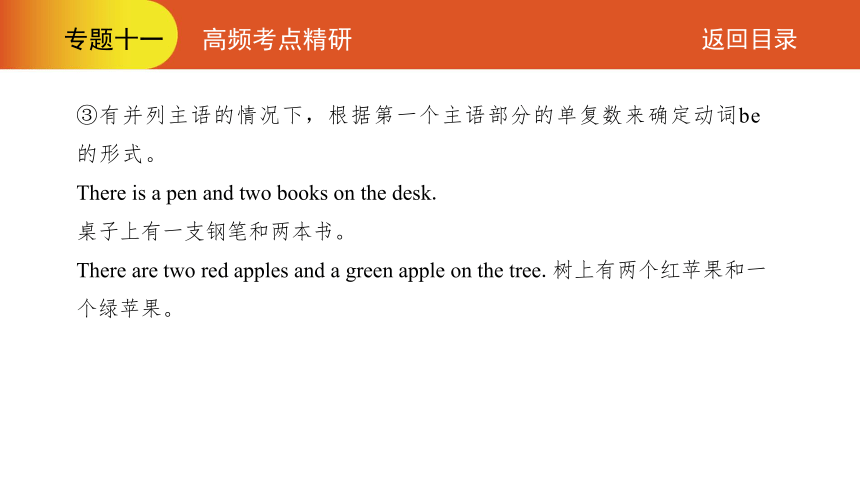
文档简介
(共54张PPT)
目录
课标知识图谱
高频考点精研
专题十一 简单句
考点1 简单句的基本类型
考点2 陈述句和疑问句
考点3 祈使句和感叹句
考点突破
课标知识图谱
1
高频考点精研
2
简单句的基本类型
简单句的基本类型
类型 谓语动词举例或说明 示例
主语(S)+
不及物动词
(V) 常见的不及物动词有arrive,
sleep, walk, happen,
come, go, laugh, die, rise
等 We worked in the same
company.
我们在同一家公司上
班。
类型 谓语动词举例或说明 示例
主语(S)+
系动词(V)
+表语(P) 常见的系动词有be,become,
grow, turn, fall, get,
look, feel, smell, sound,
taste, seem等 He became a scientist like
his father.他成了一名像
他父亲一样的科学家。
类型 谓语动词举例或说明 示例
主语(S)+
及物动词
(V)+宾语
(O) 常见的及物动词有practise,
borrow, lend, cover,
discover, enjoy, forget,guess,
invent, use, put, like,
know, raise等 He practises the piano
every day.他每天练习钢
琴。
类型 谓语动词举例或说明 示例
主语(S)+
及物动词
(V)+间接
宾语(IO)+
直接宾语
(DO) 间接宾语一般指人,直接宾语
一般指物。常见可带双宾语的
及物动词有give, pass, lend,
send, show, buy, make,
find, teach等 They offered him a good
suggestion.他们给他提供
了一个好建议。
类型 谓语动词举例或说明 示例
主语(S)+
及物动词
(V)+宾语
(O)+宾语
补足语(OC) 宾语补足语常由名词、形容
词、动词不定式等充当。常见
可带复合宾语的及物动词有
make, call, find, have,
ask, tell, keep, want, hear等 I saw him go into the
classroom.我看到他走进
了教室。
重难点
there be 句型(存现句)
①“there is/are+某物/某人+某地/某时”结构表示“某地或某时有某物或
某人”。
There are two apples on the table.
桌子上有两个苹果。
②there be句型中的be(is/are)和后面所跟的名词在数方面保持一致。
There is a school on that road.
那条路上有一所学校。
There are two girls at the school gate.
学校门口有两个女孩。
③有并列主语的情况下,根据第一个主语部分的单复数来确定动词be
的形式。
There is a pen and two books on the desk.
桌子上有一支钢笔和两本书。
There are two red apples and a green apple on the tree.树上有两个红苹果和一
个绿苹果。
④there be 句型的一般将来时为:there will be/there is/are going to be+主语
(+时间/地点)。
Look at the dark cloud!There is going to be heavy rain.看那乌云!快要下大
雨了。
陈述句和疑问句
一、陈述句
陈述句用来陈述一件事或表达一种看法,有肯定形式和否定形式,句
末用问号。
1. 陈述句的肯定形式
陈述句的肯定形式表示肯定意义,通常由主语、谓语以及其他成分构成。
This volunteer often does some shopping for the old man.这位志愿者经常为那
位老人买东西。[七下-Unit 2]
①如果句子的谓语含有be动词(am/is/are/was/were)、助动词
(will/would/have/has/had等)或情态动词(can/may/must等),其否定式是
在它们之后加not。
I am not tall.我个子不高。[七上-Unit 1]
②如果句子的谓语是实义动词,其否定形式是“do/does/did+not+动词原
形”。
She does not like sports.她不喜欢运动。[七上-Unit 2]
2. 陈述句的否定形式
①常见否定式的缩写形式:is not=isn’t; are not=aren’t; was not=
wasn’t; were not=weren’t; do not=don’t; does not=doesn’t; did not=
didn’t; will not=won’t; would not=wouldn’t; shall not=shan’t; have not
=haven’t; has not=hasn’t; had not=hadn’t; can not=can’t; must not=
mustn’t; need not=needn’t。
②am 和may与not无缩写形式。
③表示否定意义的词no, never, hardly, seldom, little, few等也可以构
成间接的否定形式。
拓展
易错点
部分否定和全部否定
含有both, all, everything, everyone(everybody)等肯定句变为否定句
时,应把这些词分别改为neither, none, nothing, no one (nobody);如
果在这些词前加not,为部分否定。
肯定句:We both are teachers.
我们两个都是教师。
否定句:Neither of us is teacher.
我们两个都不是教师。
部分否定:Not both of us are teachers.
我们两个并非都是教师。
三、疑问句
疑问句是用来提出问题的句子,句末用问号。它主要包括一般疑问
句、特殊疑问句、选择疑问句和反意疑问句。
1. 一般疑问句
一般疑问句通常用yes或no来回答。有时也可以用certainly, sure, of
course, all right, with pleasure等代替yes;用never, not at all, sorry等代
替no。
类型 问句结构
一般疑问句 以系动词be(am/is/are/was/were)开头
以助动词(do/does/did/will/would/have/has 等)开头
以情态动词(can/may/must等)开头
She lives in Jiangsu.她住在江苏。→
-Does she live in Jiangsu?她住在江苏吗?
-Yes, she does./No, she doesn’t.
——是的,她住在江苏。/不,她不住在江苏。
妙记
变一般疑问句的口诀
疑问变化不用愁,be助情提句首;
如果谓语是实义,do, does, did放句首,
动词原形在主语后。
2. 特殊疑问句
用特殊疑问词引导的以寻求信息为目的的疑问句叫特殊疑问句。疑问
词包括疑问代词、疑问副词和疑问词组:
类型 问句结构
特殊疑 问句 疑问代词(what, who, whom, which, whose)引导
疑问副词(when, why, where, how)引导
疑问词组(how many, how much, how often, how long,
how soon, how old, how far, what time等)引导
①疑问代词有:what(什么),who(谁),which(哪一个,哪些),
whose(谁的),whom(who的宾格“谁”)。
-Who is your English teacher?谁是你的英语老师?
-Miss Yang is my teacher.杨老师是我的英语老师。
②疑问副词有:when(何时),where(何地),why(为什么)和how
(怎样)。
-When did you come Taizhou?你是什么时候来到泰州的?
-In 2023.2023年。
③疑问词组:how soon(多久以后),how long(多长时间,多长长度),
how often(多久一次),how far(多远)等。
-How soon will the class meeting begin? 再过多久家长会开始?
-In thirty minutes.三十分钟后。
3. 选择疑问句
提出两种或两种以上的情况,要求对方选择一种情况回答的疑问句叫
选择疑问句。选择疑问句中的两种或两种以上的情况用or连接,回答时不用
yes或no,而要用一个完整的句子或其省略形式。语调一般是前升后降。选
择疑问句有两种结构。
类型 问句结构 示例
选择疑 问句 一般疑问句+or+被选
择部分? -Do you like bananas or apples?
你喜欢香蕉还是苹果?
-I like apples.我喜欢苹果。
特殊疑问句+A+or+
B? -Which would you like better, tea or
coffee?
你更喜欢哪种,茶还是咖啡?
-I like coffee better.我更喜欢咖啡。
4. 反意疑问句
类型 问句结构 示例
反意疑 问句 肯定陈述句+一般疑
问句的否定简略式? She can drive a car, can’t she?她会开
车,不是吗?
否定陈述句+一般疑
问句的肯定简略式? You’re not going out tonight, are
you?你今晚不出去了,是吗?
提醒
如果陈述部分含有否定词 no, little, none, nobody, nothing, few等时,其附加
疑问部分用肯定形式。
He ate nothing at night,did he?
他晚上什么都没吃,对吗?
祈使句和感叹句
一、祈使句
表示命令、请求、建议、劝告、警告或禁止等的句子是祈使句。
祈使句的主语是第二人称时,常省略。谓语动词用原形,句末用句号
或感叹号。
1. 肯定形式的祈使句
类型 结构 示例
Do型 动词原形(+宾语+其
他) Sit down, please.请坐下。
Be型 Be+表语(+其他) Be quiet.安静。
Let型 Let+宾语+动词原形
(+其他) Let me look at it.让我看看它。
2. 否定形式的祈使句
类型 结构 示例
Do型 Don’t+动词原形+宾语
(+其他) Don’t open the window.不要打
开窗。
Be型 Don’t+be+表语+其他 Don’t be late for class.上课不要
迟到。
类型 结构 示例
Let型 Don’t +let+宾语+动词
原形(+其他) Don’t let him go.不要让他走。
Let+宾语+not+动词原
形(+其他) Let him not go.让他不要走。
No/ Never型 No+doing/n.禁止…… Never+do(原形)+…
永远不要…… No photos! 禁止拍照!
Never give up!永不放弃!
提醒
有时在意思明确的情况下,祈使句中的动词也可省略。
This way, please! 请这边走。
类型 结构 示例
以what 引导 What+a/an+adj.+可数
名词单数(+主语+谓
语)! What a wonderful book(it is)!
(它是一本)多么棒的书啊!
What+adj.+可数名词
复数 (+ 主语+谓
语)! What important jobs(they have
done)!
(他们做了)多么重要的工作啊!
二、感叹句
感叹句是用来表示喜怒哀乐等感情的句子。一般用what或how引导,句
末用感叹号。
类型 结构 示例
以what 引导 What+adj.+不可数名
词 (+ 主语+谓语)! What good news (it is)!(这
是)多好的消息啊!
以how 引导 How+adj.+a/an+可数
名词单数(+主语+谓
语)! How useful a subject (it is)!(这
是)多么有用的一门学科啊!
How+adj./adv.(+主
语+谓语)! How delicious (the noodles are)!
(面条)多么美味啊!
How+主语+谓语! How time flies!时间过得真快啊!
妙记
感叹句很好辨,what, how放句前;
感叹名词用what,其余how冲在前。
拓展
1. 在陈述句、祈使句句尾加感叹号称感叹句,用来表达某种强烈的感情。
Daniel runs so fast! 丹尼尔跑得真快啊!
Be careful! 小心!
2. 用一个词或词组表示强烈感情的句子也是感叹句。
Great! 真棒!
Look out! 小心!
3. 句首有感叹词的句子也是感叹句。
Ah, I love my hometown!
啊,我爱我的家乡!
考点突破
考点1 简单句的基本类型
1. (2024南京鼓楼一模)Which of the following sentences has the same
structure as “Running is a good way to exercise.”?
A. People who run will have a healthier heart.
B. Running gives you a chance to enjoy views.
C. You can hear the wind blowing while running.
D. Starting an exercising habit sounds wonderful.
D
2. (2024扬州仪征一模) The structure of the sentence “The students visited
the museum” is .
A. S+V B. S+V+O
C. S+V+IO+DO D. S+V+DO+OC
B
3. (2024淮安一模) In the movie The Wandering Earth II, the sun becomes
bigger and will “eat” Earth.What is the sentence structure of the underlined
sentence?
A. S+V+O B. S+V+P
C. S+V+IO+DO D. S+V+DO+OC
4. (2022南京)There more than thirty selective courses in our
school.Which one would you like to choose?
A. is B. are C. have D. has
B
B
5. (2023宿迁)-There a lot of new magazines in our school reading
room.
-Oh, really? Shall we go there this afternoon?
A. is B. was C. are D. were
C
考点2 陈述句和疑问句
6. (2024常州)- is it from Changzhou to Beijing?
-It is about four hours’ ride by high-speed train.
A. How long B. How far
C. How soon D. How often
7. (2024宿迁)-Fanfan, do you read books after school every day?
-For about one hour. And I often write down my ideas while reading.
A. how far B. how long
C. how often D. how soon
B
B
8. (2024南通通州一模)-Hi, Simon. I saw you and David in the library
yesterday afternoon.
-Really? We borrowed two books on the World War Ⅱ. We have a lot in
common.
What does the sentence“We have a lot in common.” mean here?
A. We have similar interests.
B. We are in the same school.
C. David’s book is similar to mine.
D. The books we borrowed look similar.
A
9. (2024无锡新吴一模)-Laura, you seem thirsty. would you like to
drink?
-Just water, please.
A. Where B. When
C. What D. Who
C
10. (2024南通海安十三校联考二模)- will the 2024 Paris Olympic
Games be held?
-It will be held in more than one month and the opening ceremony is on 26th
July.
A. How far B. How long
C. How soon D. How often
C
11. (2024南通启东二模)-Tom, will your school’s sports meeting
take place?
-I have no idea. Maybe in a couple of weeks.
A. how soon B. how long
C. how far D. how often
A
12. (2024南通通州等两地二模)- made you decide to open a guest
house?
-We have green mountains and clear waters here, and every year many tourists
come to visit.
A. What B. How
C. When D. Who
A
13. (2023淮安)-Mr Wu, can I keep the guitar?
-For five days.
A. how often B. how soon
C. how long D. how much
14. (2023南通)-Excuse me, is the Gengsu Theatre from this hotel?
-It’s about ten minutes if you take a taxi.
A. how far B. how long
C. how soon D. how much
C
A
15. (2022南京)-The 10th Reading Festival is being held in your
school. does it last?
-About fourteen days.
A. How often B. How far
C. How soon D. How long
D
考点3 祈使句和感叹句
16. (2024宿迁)- fine weather! It’s a good match for going on a
picnic.
-Exactly. I simply can’t wait!
A. How B. What
C. How a D. What a
B
17. (2024南京秦淮一模)-Do you know David got full marks in the PE
test?
-Good for him! exciting the news is!
A. How B. How an
C. What D. What an
18. (2024南通崇川、如皋一模) fast to your dreams, for if dreams
die, life is like a broken-winged bird that can never fly.
A. Hold B. To hold
C. Held D. Holding
A
A
19. (2024南通海安一模) - unforgettable experience I had
in Harbin Ice and Snow World!
-I’m glad you had a good time.
A. What an B. What
C. How an D. How
20. (2024南通通州一模)-I went to the charity as a volunteer last Sunday.
-Good job! meaningful experience it was!
A. What B. What a
C. How D. How a
A
B
21. (2024扬州仪征一模) at the door before you enter my room,
please.
A. Knocked B. Knocking
C. Knock D. To knock
22. (2024南京江宁高新区中学三模) smart the robot is! It can work
out most of the problems.
A. What B. What a
C. How D. How a
C
C
23. (2024南通启东二模)- fast the North high-speed railway along
the Yangtze River from Qidong to Shanghai will move!
-Of course. Besides that, the environment inside will also be comfortable.
A. What B. What a
C. How D. How a
24. (2024扬州广陵二模) that Tony missed the concert he had looked
forward to!
A. What shame B. What a shame
C. How shame D. How a shame
C
B
25. (2023泰州)“Hello, my dear friend.What a lucky day I’m sure
you will do well in this exam.” Which of the following fits in the blank best?
A. ! B. , C. ? D. .
26. (2023淮安)The C919, China’s self-made large plane, is now in
use. exciting the news is!
A. How B. How an
C. What D. What an
A
A
27. (2022南京) amazing activity! I will never forget the charity
show.
A. How B. What
C. How an D. What an
D
目录
课标知识图谱
高频考点精研
专题十一 简单句
考点1 简单句的基本类型
考点2 陈述句和疑问句
考点3 祈使句和感叹句
考点突破
课标知识图谱
1
高频考点精研
2
简单句的基本类型
简单句的基本类型
类型 谓语动词举例或说明 示例
主语(S)+
不及物动词
(V) 常见的不及物动词有arrive,
sleep, walk, happen,
come, go, laugh, die, rise
等 We worked in the same
company.
我们在同一家公司上
班。
类型 谓语动词举例或说明 示例
主语(S)+
系动词(V)
+表语(P) 常见的系动词有be,become,
grow, turn, fall, get,
look, feel, smell, sound,
taste, seem等 He became a scientist like
his father.他成了一名像
他父亲一样的科学家。
类型 谓语动词举例或说明 示例
主语(S)+
及物动词
(V)+宾语
(O) 常见的及物动词有practise,
borrow, lend, cover,
discover, enjoy, forget,guess,
invent, use, put, like,
know, raise等 He practises the piano
every day.他每天练习钢
琴。
类型 谓语动词举例或说明 示例
主语(S)+
及物动词
(V)+间接
宾语(IO)+
直接宾语
(DO) 间接宾语一般指人,直接宾语
一般指物。常见可带双宾语的
及物动词有give, pass, lend,
send, show, buy, make,
find, teach等 They offered him a good
suggestion.他们给他提供
了一个好建议。
类型 谓语动词举例或说明 示例
主语(S)+
及物动词
(V)+宾语
(O)+宾语
补足语(OC) 宾语补足语常由名词、形容
词、动词不定式等充当。常见
可带复合宾语的及物动词有
make, call, find, have,
ask, tell, keep, want, hear等 I saw him go into the
classroom.我看到他走进
了教室。
重难点
there be 句型(存现句)
①“there is/are+某物/某人+某地/某时”结构表示“某地或某时有某物或
某人”。
There are two apples on the table.
桌子上有两个苹果。
②there be句型中的be(is/are)和后面所跟的名词在数方面保持一致。
There is a school on that road.
那条路上有一所学校。
There are two girls at the school gate.
学校门口有两个女孩。
③有并列主语的情况下,根据第一个主语部分的单复数来确定动词be
的形式。
There is a pen and two books on the desk.
桌子上有一支钢笔和两本书。
There are two red apples and a green apple on the tree.树上有两个红苹果和一
个绿苹果。
④there be 句型的一般将来时为:there will be/there is/are going to be+主语
(+时间/地点)。
Look at the dark cloud!There is going to be heavy rain.看那乌云!快要下大
雨了。
陈述句和疑问句
一、陈述句
陈述句用来陈述一件事或表达一种看法,有肯定形式和否定形式,句
末用问号。
1. 陈述句的肯定形式
陈述句的肯定形式表示肯定意义,通常由主语、谓语以及其他成分构成。
This volunteer often does some shopping for the old man.这位志愿者经常为那
位老人买东西。[七下-Unit 2]
①如果句子的谓语含有be动词(am/is/are/was/were)、助动词
(will/would/have/has/had等)或情态动词(can/may/must等),其否定式是
在它们之后加not。
I am not tall.我个子不高。[七上-Unit 1]
②如果句子的谓语是实义动词,其否定形式是“do/does/did+not+动词原
形”。
She does not like sports.她不喜欢运动。[七上-Unit 2]
2. 陈述句的否定形式
①常见否定式的缩写形式:is not=isn’t; are not=aren’t; was not=
wasn’t; were not=weren’t; do not=don’t; does not=doesn’t; did not=
didn’t; will not=won’t; would not=wouldn’t; shall not=shan’t; have not
=haven’t; has not=hasn’t; had not=hadn’t; can not=can’t; must not=
mustn’t; need not=needn’t。
②am 和may与not无缩写形式。
③表示否定意义的词no, never, hardly, seldom, little, few等也可以构
成间接的否定形式。
拓展
易错点
部分否定和全部否定
含有both, all, everything, everyone(everybody)等肯定句变为否定句
时,应把这些词分别改为neither, none, nothing, no one (nobody);如
果在这些词前加not,为部分否定。
肯定句:We both are teachers.
我们两个都是教师。
否定句:Neither of us is teacher.
我们两个都不是教师。
部分否定:Not both of us are teachers.
我们两个并非都是教师。
三、疑问句
疑问句是用来提出问题的句子,句末用问号。它主要包括一般疑问
句、特殊疑问句、选择疑问句和反意疑问句。
1. 一般疑问句
一般疑问句通常用yes或no来回答。有时也可以用certainly, sure, of
course, all right, with pleasure等代替yes;用never, not at all, sorry等代
替no。
类型 问句结构
一般疑问句 以系动词be(am/is/are/was/were)开头
以助动词(do/does/did/will/would/have/has 等)开头
以情态动词(can/may/must等)开头
She lives in Jiangsu.她住在江苏。→
-Does she live in Jiangsu?她住在江苏吗?
-Yes, she does./No, she doesn’t.
——是的,她住在江苏。/不,她不住在江苏。
妙记
变一般疑问句的口诀
疑问变化不用愁,be助情提句首;
如果谓语是实义,do, does, did放句首,
动词原形在主语后。
2. 特殊疑问句
用特殊疑问词引导的以寻求信息为目的的疑问句叫特殊疑问句。疑问
词包括疑问代词、疑问副词和疑问词组:
类型 问句结构
特殊疑 问句 疑问代词(what, who, whom, which, whose)引导
疑问副词(when, why, where, how)引导
疑问词组(how many, how much, how often, how long,
how soon, how old, how far, what time等)引导
①疑问代词有:what(什么),who(谁),which(哪一个,哪些),
whose(谁的),whom(who的宾格“谁”)。
-Who is your English teacher?谁是你的英语老师?
-Miss Yang is my teacher.杨老师是我的英语老师。
②疑问副词有:when(何时),where(何地),why(为什么)和how
(怎样)。
-When did you come Taizhou?你是什么时候来到泰州的?
-In 2023.2023年。
③疑问词组:how soon(多久以后),how long(多长时间,多长长度),
how often(多久一次),how far(多远)等。
-How soon will the class meeting begin? 再过多久家长会开始?
-In thirty minutes.三十分钟后。
3. 选择疑问句
提出两种或两种以上的情况,要求对方选择一种情况回答的疑问句叫
选择疑问句。选择疑问句中的两种或两种以上的情况用or连接,回答时不用
yes或no,而要用一个完整的句子或其省略形式。语调一般是前升后降。选
择疑问句有两种结构。
类型 问句结构 示例
选择疑 问句 一般疑问句+or+被选
择部分? -Do you like bananas or apples?
你喜欢香蕉还是苹果?
-I like apples.我喜欢苹果。
特殊疑问句+A+or+
B? -Which would you like better, tea or
coffee?
你更喜欢哪种,茶还是咖啡?
-I like coffee better.我更喜欢咖啡。
4. 反意疑问句
类型 问句结构 示例
反意疑 问句 肯定陈述句+一般疑
问句的否定简略式? She can drive a car, can’t she?她会开
车,不是吗?
否定陈述句+一般疑
问句的肯定简略式? You’re not going out tonight, are
you?你今晚不出去了,是吗?
提醒
如果陈述部分含有否定词 no, little, none, nobody, nothing, few等时,其附加
疑问部分用肯定形式。
He ate nothing at night,did he?
他晚上什么都没吃,对吗?
祈使句和感叹句
一、祈使句
表示命令、请求、建议、劝告、警告或禁止等的句子是祈使句。
祈使句的主语是第二人称时,常省略。谓语动词用原形,句末用句号
或感叹号。
1. 肯定形式的祈使句
类型 结构 示例
Do型 动词原形(+宾语+其
他) Sit down, please.请坐下。
Be型 Be+表语(+其他) Be quiet.安静。
Let型 Let+宾语+动词原形
(+其他) Let me look at it.让我看看它。
2. 否定形式的祈使句
类型 结构 示例
Do型 Don’t+动词原形+宾语
(+其他) Don’t open the window.不要打
开窗。
Be型 Don’t+be+表语+其他 Don’t be late for class.上课不要
迟到。
类型 结构 示例
Let型 Don’t +let+宾语+动词
原形(+其他) Don’t let him go.不要让他走。
Let+宾语+not+动词原
形(+其他) Let him not go.让他不要走。
No/ Never型 No+doing/n.禁止…… Never+do(原形)+…
永远不要…… No photos! 禁止拍照!
Never give up!永不放弃!
提醒
有时在意思明确的情况下,祈使句中的动词也可省略。
This way, please! 请这边走。
类型 结构 示例
以what 引导 What+a/an+adj.+可数
名词单数(+主语+谓
语)! What a wonderful book(it is)!
(它是一本)多么棒的书啊!
What+adj.+可数名词
复数 (+ 主语+谓
语)! What important jobs(they have
done)!
(他们做了)多么重要的工作啊!
二、感叹句
感叹句是用来表示喜怒哀乐等感情的句子。一般用what或how引导,句
末用感叹号。
类型 结构 示例
以what 引导 What+adj.+不可数名
词 (+ 主语+谓语)! What good news (it is)!(这
是)多好的消息啊!
以how 引导 How+adj.+a/an+可数
名词单数(+主语+谓
语)! How useful a subject (it is)!(这
是)多么有用的一门学科啊!
How+adj./adv.(+主
语+谓语)! How delicious (the noodles are)!
(面条)多么美味啊!
How+主语+谓语! How time flies!时间过得真快啊!
妙记
感叹句很好辨,what, how放句前;
感叹名词用what,其余how冲在前。
拓展
1. 在陈述句、祈使句句尾加感叹号称感叹句,用来表达某种强烈的感情。
Daniel runs so fast! 丹尼尔跑得真快啊!
Be careful! 小心!
2. 用一个词或词组表示强烈感情的句子也是感叹句。
Great! 真棒!
Look out! 小心!
3. 句首有感叹词的句子也是感叹句。
Ah, I love my hometown!
啊,我爱我的家乡!
考点突破
考点1 简单句的基本类型
1. (2024南京鼓楼一模)Which of the following sentences has the same
structure as “Running is a good way to exercise.”?
A. People who run will have a healthier heart.
B. Running gives you a chance to enjoy views.
C. You can hear the wind blowing while running.
D. Starting an exercising habit sounds wonderful.
D
2. (2024扬州仪征一模) The structure of the sentence “The students visited
the museum” is .
A. S+V B. S+V+O
C. S+V+IO+DO D. S+V+DO+OC
B
3. (2024淮安一模) In the movie The Wandering Earth II, the sun becomes
bigger and will “eat” Earth.What is the sentence structure of the underlined
sentence?
A. S+V+O B. S+V+P
C. S+V+IO+DO D. S+V+DO+OC
4. (2022南京)There more than thirty selective courses in our
school.Which one would you like to choose?
A. is B. are C. have D. has
B
B
5. (2023宿迁)-There a lot of new magazines in our school reading
room.
-Oh, really? Shall we go there this afternoon?
A. is B. was C. are D. were
C
考点2 陈述句和疑问句
6. (2024常州)- is it from Changzhou to Beijing?
-It is about four hours’ ride by high-speed train.
A. How long B. How far
C. How soon D. How often
7. (2024宿迁)-Fanfan, do you read books after school every day?
-For about one hour. And I often write down my ideas while reading.
A. how far B. how long
C. how often D. how soon
B
B
8. (2024南通通州一模)-Hi, Simon. I saw you and David in the library
yesterday afternoon.
-Really? We borrowed two books on the World War Ⅱ. We have a lot in
common.
What does the sentence“We have a lot in common.” mean here?
A. We have similar interests.
B. We are in the same school.
C. David’s book is similar to mine.
D. The books we borrowed look similar.
A
9. (2024无锡新吴一模)-Laura, you seem thirsty. would you like to
drink?
-Just water, please.
A. Where B. When
C. What D. Who
C
10. (2024南通海安十三校联考二模)- will the 2024 Paris Olympic
Games be held?
-It will be held in more than one month and the opening ceremony is on 26th
July.
A. How far B. How long
C. How soon D. How often
C
11. (2024南通启东二模)-Tom, will your school’s sports meeting
take place?
-I have no idea. Maybe in a couple of weeks.
A. how soon B. how long
C. how far D. how often
A
12. (2024南通通州等两地二模)- made you decide to open a guest
house?
-We have green mountains and clear waters here, and every year many tourists
come to visit.
A. What B. How
C. When D. Who
A
13. (2023淮安)-Mr Wu, can I keep the guitar?
-For five days.
A. how often B. how soon
C. how long D. how much
14. (2023南通)-Excuse me, is the Gengsu Theatre from this hotel?
-It’s about ten minutes if you take a taxi.
A. how far B. how long
C. how soon D. how much
C
A
15. (2022南京)-The 10th Reading Festival is being held in your
school. does it last?
-About fourteen days.
A. How often B. How far
C. How soon D. How long
D
考点3 祈使句和感叹句
16. (2024宿迁)- fine weather! It’s a good match for going on a
picnic.
-Exactly. I simply can’t wait!
A. How B. What
C. How a D. What a
B
17. (2024南京秦淮一模)-Do you know David got full marks in the PE
test?
-Good for him! exciting the news is!
A. How B. How an
C. What D. What an
18. (2024南通崇川、如皋一模) fast to your dreams, for if dreams
die, life is like a broken-winged bird that can never fly.
A. Hold B. To hold
C. Held D. Holding
A
A
19. (2024南通海安一模) - unforgettable experience I had
in Harbin Ice and Snow World!
-I’m glad you had a good time.
A. What an B. What
C. How an D. How
20. (2024南通通州一模)-I went to the charity as a volunteer last Sunday.
-Good job! meaningful experience it was!
A. What B. What a
C. How D. How a
A
B
21. (2024扬州仪征一模) at the door before you enter my room,
please.
A. Knocked B. Knocking
C. Knock D. To knock
22. (2024南京江宁高新区中学三模) smart the robot is! It can work
out most of the problems.
A. What B. What a
C. How D. How a
C
C
23. (2024南通启东二模)- fast the North high-speed railway along
the Yangtze River from Qidong to Shanghai will move!
-Of course. Besides that, the environment inside will also be comfortable.
A. What B. What a
C. How D. How a
24. (2024扬州广陵二模) that Tony missed the concert he had looked
forward to!
A. What shame B. What a shame
C. How shame D. How a shame
C
B
25. (2023泰州)“Hello, my dear friend.What a lucky day I’m sure
you will do well in this exam.” Which of the following fits in the blank best?
A. ! B. , C. ? D. .
26. (2023淮安)The C919, China’s self-made large plane, is now in
use. exciting the news is!
A. How B. How an
C. What D. What an
A
A
27. (2022南京) amazing activity! I will never forget the charity
show.
A. How B. What
C. How an D. What an
D
同课章节目录
- 词法
- 名词
- 动词和动词短语
- 动词语态
- 动词时态
- 助动词和情态动词
- 非谓语动词
- 冠词
- 代词
- 数词和量词
- 形容词副词及其比较等级
- 介词和介词短语
- 连词和感叹词
- 构词法
- 相似、相近词比较
- 句法
- 陈述句
- 一般疑问句和否定疑问句
- 特殊疑问句及选择疑问句
- 反意疑问句
- 存在句(There be句型)
- 宾语从句
- 定语从句
- 状语从句
- 主谓一致问题
- 简单句
- 并列句
- 复合句
- 主谓一致
- 主、表语从句
- 名词性从句
- 直接引语和间接引语
- 虚拟语气
- 感叹句
- 强调句
- 倒装句
- 祈使句
- 句子的成分
- 句子的分类
- 题型专区
- 单项选择部分
- 易错题
- 完形填空
- 阅读理解
- 词汇练习
- 听说训练
- 句型转换
- 补全对话
- 短文改错
- 翻译
- 书面表达
- 任务型阅读
- 语法填空
- 其他资料
